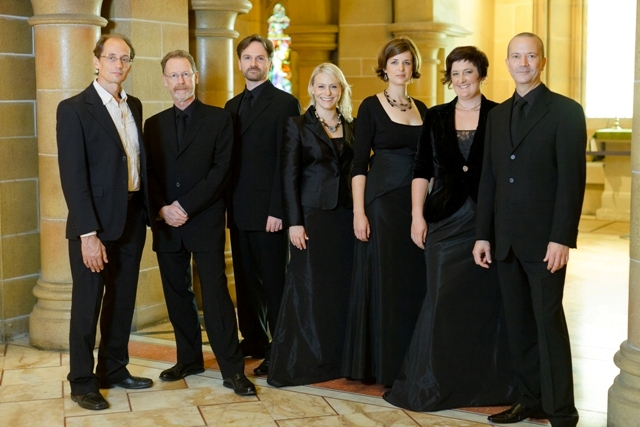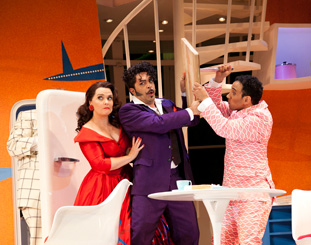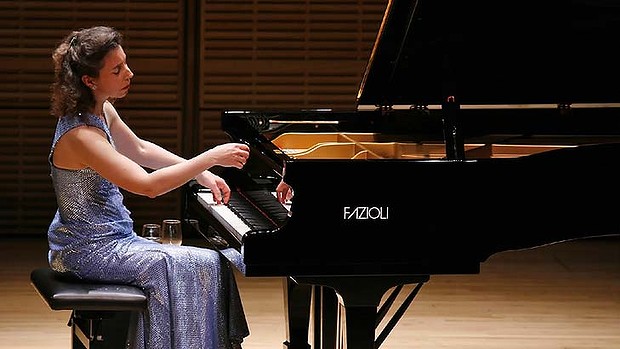Danielle de Niese with the Australian Chamber Orchestra

On hearing that I was attending the opening night of Danielle de Niese’s concert season with the Australian Chamber Orchestra in Sydney, a friend asked me to let him know whether I thought he should go along to hear her.
Twenty four hours after the concert, I’m still deliberating on my response to him.
Danielle de Niese is indeed a beautiful singer in every sense of the word. Her performance was flawless. Yet, I came away feeling that something was lacking. I needed to hear more of her, especially in repertoire for which she has become so lauded.
The Australian Chamber Orchestra, led by Richard Tognetti performed superbly, opening the programme with Mozart’s Symphony K196/121, La finta giardiniera, derived from the overture to the eponymous opera.
Then the moment we had been anticipating as Danielle de Niese entered the stage, vivacious, sultry, engaging. The mood sobered as the strings launched into the opening bars of the world premiere of Carl Vine’s The Tree of Man, a secular cantata for soprano and string orchestra based on the final chapter of Nobel Prize winning Patrick White’s novel. The work is dedicated to de Niese. Carl Vine, who was present at the concert, says in his programme notes that The Tree of Man is one of his favourites amongst White’s novels, “sit(ting) for me near the pinnacle of English literature, (providing), in its short final chapter, a concise summary, not of the action of the rest of the book, but somehow of its very essence”.
Of the pairing of words and music, he says “I wanted to avoid setting the whole thing as Recitative, the operatic form that uses staggering rhythms to denote words spoken ‘naturally’. Fortunately, the text is full of lilting, natural and repetitive rhythms, which I have heightened with simple step-wise melody and accompaniment that emphasises its regularities. Although this setting contains little plain triadic harmony, I have endeavoured to reflect, in every aspect of the music, the simplicity and sincerity of the novel’s language”.
At last! An original work from an Australian composer based on text by an Australian writer that expresses an Australian aesthetic. At first hearing, The Tree of Man seems to be the cultural equivalent of Andre Previn’s Honey and Rue, written for soprano Kathleen Battle, which has words by Pulitzer Prize winning Toni Morrison. Danielle de Niese brought vivid colours and depth of emotion to her lyrical performance. What I am uncertain of is whether I can tell my friend that the writing brought out the best in her voice, given what she has achieved in her brief but spectacular career.
Richard Meale’s Cantilena Pacifica for violin and strings, continued the sombre theme. Written as a memorial to a close friend, it was performed with exquisite control by the orchestra with Tognetti as soloist.
Mozart’s Exultate Jubilate brought some much needed relief to the mood and the irrepressible Danielle de Niese was clearly at home with this style. Her performance was pure joy, with a coloratura that flowed and shimmered and an ending that exuded triumph.
The second half of the programme returned to the dark side with two visions of Schubert’s Death and the Maiden, transcribed by Tognetti. First the lied, D 531 re-invented for soprano and strings. Again Danielle de Niese told the story well, but it seemed to easy for her and her presence was all too brief. She left the stage and we were treated to Tognetti’s vision of the String Quartet no 14, D 810, arranged for the chamber orchestra, the longest work in the programme.
So how to guide my friend? I would recommend highly that he hear her. However, there are cautions.
If you go along to hear de Niese in full flight, you will be disappointed. The works she sang were beautiful, but bread and butter repertoire. This is a soprano who has dazzled on the world’s stages in roles like Handel’s Cleopatra, Susanna in Mozart’s Figaro, Norina in Donizzetti’s Don Pasquale and Euridice in Gluck’s Orfeo ed Euridice. Since 2008 she has made 4 CDs, the first of which (Handel arias) received several citations, amongst them the Orphee D’Or from the Academie Du Disque Lyrique, and a nomination for the 2009 Classical Brit Award Female Artist of the Year.
I would reserve my opinions until I have a more complete picture of the artist. I want to hear her sing opera,with all its demands in the acoustic of an opera theatre; I want to hear her present a full recital, with all its claims on stamina, language and narrative skill.
Until then, I don’t believe that Australian audiences can get the measure of this rare being that is still emerging from its chrysalis.
Am I glad that I heard her despite these limitations? You bet!
Shamistha de Soysa for SoundsLikeSydney.
Read Murray Black’s review in The Australian:
Further Sydney performances at the City Recital Hall on Tuesday 12th and Wednesday the 13th June, and at the Sydney Opera House on Sunday 24th June






